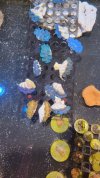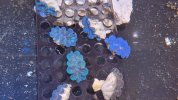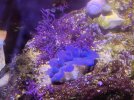We just received 10 small Ultra Maxima clams, 2 deresa, and 2 crocea. Come quick to get best pick. $60 for BAR members.
You are using an out of date browser. It may not display this or other websites correctly.
You should upgrade or use an alternative browser.
You should upgrade or use an alternative browser.
More small clams in! Maxima, deresa, and crocea.
- Thread starter ClearWaterAquarium
- Start date
B the Nano Reefer
Supporting Member
Are these wild or aquaculture?
Pics of the 10 small Ultra Maxima clams?
Pics of the 10 small Ultra Maxima clams?
Clam fact: any tridacnid in the store under 3" or so is almost 100% cultured. The wild clams are always large due to age.Are these wild or aquaculture?
Pics of the 10 small Ultra Maxima clams?
Now I want a second clam…
First clam from CWA is doing great, big growth rim and it grew a new set of scutes
Check for pyramid snails, always, regardless of source, freshwater dip + heavy basting knocked them off and clam opened immediately after the dip.
Pic from a week ago

And yesterday after algae scraping, when it closed partially, you can see its new growth

First clam from CWA is doing great, big growth rim and it grew a new set of scutes
Check for pyramid snails, always, regardless of source, freshwater dip + heavy basting knocked them off and clam opened immediately after the dip.
Pic from a week ago
And yesterday after algae scraping, when it closed partially, you can see its new growth
Last edited:
Crazy contrast in them colors !!!!Now I want a second clam…
First clam from CWA is doing great, big growth rim and it grew a new set of scutes
Check for pyramid snails, always, regardless of source, freshwater dip + heavy basting knocked them off and clam opened immediately after the dip.
Pic from a week ago
View attachment 60229
And yesterday after algae scraping, when it closed partially, you can see its new growth
View attachment 60230
Kensington Reefer
Supporting Member
new family heirloom, passed down over generations: clam
Kensington Reefer
Supporting Member
Make it so!!new family heirloom, passed down over generations: clam
I'll be annoying but even the longest kept gigas in Waikiki lasted about 40 years. Pretty sure @tribbitt will outlast even two more of those!
Thanks for the great offer! I wish I were closer. I'd love to add another clam to the mix.We just received 10 small Ultra Maxima clams, 2 deresa, and 2 crocea. Come quick to get best pick. $60 for BAR members.
Be sure to buffer the pH in any future freshwater dips, RODI water is usually close to 7.0 since it has zero buffering capacity.Picked one up yesterday, rodi dip and tossed it in the tank. Healthy clams bounced right back within minutes.
Highly recommend picking up this book since it taught me 90% of what I know about clams: https://www.saltwateraquarium.com/g...pZzq8XFBCP0bCdfrJuXg2eOK7haHBdLAw0mtVuRHHarM0
I thought RO water was typically acidic in the 5.5-6 range? With other variables that can bring up the pH to 7.Be sure to buffer the pH in any future freshwater dips, RODI water is usually close to 7.0 since it has zero buffering capacity.
Thanks for the book suggestion. Will definitely be looking to add that one. I've been enjoying my clam quite a bit.
I thought RO water was typically acidic in the 5.5-6 range? With other variables that can bring up the pH to 7.
Thanks for the book suggestion. Will definitely be looking to add that one. I've been enjoying my clam quite a bit.
It typically is between 5-6 because of atmospheric CO2. It could be 7 if it was just made and a measurement was taken rather quickly or made/stored in a vacuum without exposure to CO2.
Last edited:
That's true, it depends on the purity and how clean the container is too. I wonder how long it takes for the shell to melt and buffer the solution lolIt typically is between 5-6 because of atmospheric CO2. It could be 7 if it was just made and a measurement was taken rather quickly or made/stored in a vacuum with exposure to CO2.
I didn’t and the clam didn’t care much. Opened after a few mins.Be sure to buffer the pH in any future freshwater dips, RODI water is usually close to 7.0 since it has zero buffering capacity.
Highly recommend picking up this book since it taught me 90% of what I know about clams: https://www.saltwateraquarium.com/g...pZzq8XFBCP0bCdfrJuXg2eOK7haHBdLAw0mtVuRHHarM0
They get rained on in the wild



